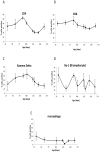Immunological changes at point-of-lay increase susceptibility to Salmonella enterica Serovar enteritidis infection in vaccinated chickens
- PMID: 23133568
- PMCID: PMC3485033
- DOI: 10.1371/journal.pone.0048195
Immunological changes at point-of-lay increase susceptibility to Salmonella enterica Serovar enteritidis infection in vaccinated chickens
Abstract
Chicken eggs are the main source of human Salmonella enterica serovar Enteritidis infection. S. Enteritidis infects the oviduct and ovary of the chicken leading to infection of developing eggs. Therefore, control in poultry production is a major public health priority. Vaccination of hens has proved successful in control strategies in United Kingdom leading to a 70% drop in human cases since introduced. However, as hens reach sexual maturity they become immunosuppressed and it has been postulated this leads to increased susceptibility to Salmonella infection. In this study we define the changes to the systemic and reproductive tract-associated immune system of hens throughout sexual development by flow cytometry and histology and determine changes in susceptibility to experimental S. Enteritidis challenge in naive and vaccinated hens. Changes to both systemic and local immune systems occur in chickens at sexual development around 140 days of age. The population of several leukocyte classes drop, with the greatest fall in CD4+ lymphocyte numbers. Within the developing reproductive tract there an organised structure of lymphocytic aggregates with γδ-T lymphocytes associated with the mucosa. At point-of-lay, this organised structure disappears and only scattered lymphocytes remain. Protection against Salmonella challenge is significantly reduced in vaccinated birds at point-of-lay, coinciding with the drop in CD4+ lymphocytes. Susceptibility to reproductive tract infection by Salmonella increased in vaccinated and naïve animals at 140 and 148 days of age. We hypothesise that the drop in γδ-T lymphocytes in the tract leads to decreased innate protection of the mucosa to infection. These findings indicate that systemic and local changes to the immune system increase the susceptibility of hens to S. Enteritidis infection. The loss of protective immunity in vaccinated birds demonstrates that Salmonella control should not rely on vaccination alone, but as part of an integrated control strategy including biosecurity and improved animal welfare.
Conflict of interest statement
Figures




Similar articles
-
Infection of the reproductive tract and eggs with Salmonella enterica serovar pullorum in the chicken is associated with suppression of cellular immunity at sexual maturity.Infect Immun. 2005 May;73(5):2986-90. doi: 10.1128/IAI.73.5.2986-2990.2005. Infect Immun. 2005. PMID: 15845505 Free PMC article.
-
Cytokine signaling in splenic leukocytes from vaccinated and non-vaccinated chickens after intravenous infection with Salmonella enteritidis.PLoS One. 2012;7(2):e32346. doi: 10.1371/journal.pone.0032346. Epub 2012 Feb 24. PLoS One. 2012. PMID: 22384225 Free PMC article.
-
Effects of Salmonella enterica subsp. enterica serovar Enteritidis vaccination in layer hens subjected to S. Enteritidis challenge and various feed withdrawal regimens.Vet Microbiol. 2007 Nov 15;125(1-2):111-9. doi: 10.1016/j.vetmic.2007.05.008. Epub 2007 May 18. Vet Microbiol. 2007. PMID: 17624693
-
A critical review of Salmonella Typhimurium infection in laying hens.Avian Pathol. 2011 Oct;40(5):429-36. doi: 10.1080/03079457.2011.606799. Epub 2011 Aug 31. Avian Pathol. 2011. PMID: 21879803 Review.
-
The immunobiology of avian systemic salmonellosis.Vet Immunol Immunopathol. 2009 Mar 15;128(1-3):53-9. doi: 10.1016/j.vetimm.2008.10.295. Epub 2008 Oct 17. Vet Immunol Immunopathol. 2009. PMID: 19070366 Review.
Cited by
-
Salmonella enterica serovar enteritidis antimicrobial peptide resistance genes aid in defense against chicken innate immunity, fecal shedding, and egg deposition.Infect Immun. 2014 Dec;82(12):5185-202. doi: 10.1128/IAI.02387-14. Epub 2014 Sep 29. Infect Immun. 2014. PMID: 25267840 Free PMC article.
-
Prevalence, Serotype, Antibiotic Susceptibility, and Genotype of Salmonella in Eggs From Poultry Farms and Marketplaces in Yangling, Shaanxi Province, China.Front Microbiol. 2020 Aug 4;11:1482. doi: 10.3389/fmicb.2020.01482. eCollection 2020. Front Microbiol. 2020. PMID: 32903897 Free PMC article.
-
Role of StdA in adhesion of Salmonella enterica serovar Enteritidis phage type 8 to host intestinal epithelial cells.Gut Pathog. 2013 Dec 24;5(1):43. doi: 10.1186/1757-4749-5-43. Gut Pathog. 2013. PMID: 24367906 Free PMC article.
-
Cecal MicroRNAome response to Salmonella enterica serovar Enteritidis infection in White Leghorn Layer.BMC Genomics. 2017 Jan 13;18(1):77. doi: 10.1186/s12864-016-3413-8. BMC Genomics. 2017. PMID: 28086873 Free PMC article.
-
Invasive non-typhoidal Salmonella typhimurium ST313 are not host-restricted and have an invasive phenotype in experimentally infected chickens.PLoS Negl Trop Dis. 2013 Oct 10;7(10):e2487. doi: 10.1371/journal.pntd.0002487. eCollection 2013. PLoS Negl Trop Dis. 2013. PMID: 24130915 Free PMC article.
References
-
- CDC (2010) Investigation Update: Multistate Outbreak of Human Salmonella Enteritidis Infections Associated with Shell Eggs. Centers for Disease Control.
-
- Gast RK, Guraya R, Guard-Bouldin J, Holt PS, Moore RW (2007) Colonization of specific regions of the reproductive tract and deposition at different locations inside eggs laid by hens infected with Salmonella Enteritidis or Salmonella Heidelberg. Avian diseases 51: 40–44. - PubMed
-
- Guard-Petter J (2001) The chicken, the egg and Salmonella enteritidis. Environmental microbiology 3: 421–430. - PubMed
-
- Gantois I, Ducatelle R, Pasmans F, Haesebrouck F, Gast R, et al. (2009) Mechanisms of egg contamination by Salmonella Enteritidis. FEMS microbiology reviews 33: 718–738. - PubMed
Publication types
MeSH terms
Substances
Grants and funding
LinkOut - more resources
Full Text Sources
Research Materials

